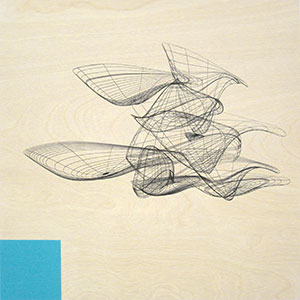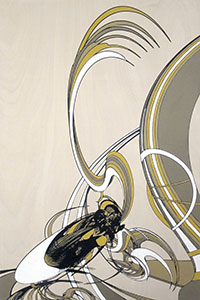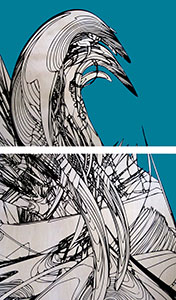REGARDING THE WORKS IN GOLDBERG’S IMPROBABLE FORMS EXHIBITION.
EW – There seems to be a great disparity between working on a screen and ending up with a painting on a wood panel on the wall- Can you talk about the differences in position and context this brings up?

Wireframe with Blue Square, 2013. ‘Wireframe’ Series.
CG– In terms of context, the show brings together ideas from two bodies of work – the Wireframe series, begun on paper in 2005, and the more recent Biomorphic series, begun on canvas last year. The Wireframes are certainly closer to formalist abstraction; essentially they are volumetric gestures, perhaps suggestive of scenes, structures or organisms.
I feel that one of my goals as an artist is not only to utilize technology as a means of production but actually to reference it directly within the content of my work. Wireframe models, generally found on the computer screens of architects and engineers, assume a different meaning (and feeling) when recontextualized onto a piece of wood or as a painted canvas.
The Biomorphic works exert a more figurative impulse; their linework, inspired in part by Japanese woodcuts, suggests forms and scenes which are at once mechanistic and organic. All of the works within the Improbable Forms exhibition explore multiple dualities: the gesture and control, the past and the future, abstraction and figuration.
EW – Is the computer your partner?

Hachi, 2013. “Biormorphic” Series.
CG– I would say that I see the computer both as an extension of myself and as a partner. It is a tool to be used like a brush or a pen. However, I think the computer differs greatly from other tools that humans have developed in the past, as it is truly a tool for the mind. The machine opens up new approaches not only in terms of execution, but within the areas of ideation and conceptualization as well.
For everyday purposes, I use the machine and its software. When I make art, I play with it. The work is knowing when to stop playing. Playing with software can often result in very unexpected results – it’s much like engaging in the Surrealist game The Exquisite Corpse, except it is with a machine instead of with human participants – you never really know what results will emerge. Working digitally, for me, taps into the subconscious impulse in a similar way that the Surrealists used wordplay and automatic drawing. Consciousness only gets involved when the decision is made to hit the “save” button. When people ask me if my work is computer-generated, I usually reply that I consider it computer-assisted.
EW – Where would you place yourself between the poles of abstraction / formalism and figuration?

Iruka, 2013. “Biomorphic” series.
CG – My work has swung like a pendulum in that regard. Through my undergraduate studies, I was interested mostly in surrealist ideas. When I began my digital tablet drawings, around 1994, I became more open to exploring abstraction. Angelo Ippolito, one of my undergraduate painting professors at Binghamton, was a New York School ab-ex painter. He explained that his work was “about paint”. It wasn’t until I began to use technology that my work started to become “about technology”.
Instead of beginning with a sketch that is developed into a finished painting, a more intuitive and expressionistic working approach took root, where the process of composition would happen organically on a more subconscious level. The conscious component would come afterward, in the titling of the work upon consideration of the results.
Working within this modality for the past fifteen years, the pendulum has started to swing back toward figuration, and the results have begun to resemble things again. If I can easily identify a form I have created as something real, I usually feel that I have overworked it, yet if it is formally balanced without the implication or suggestion of something more, then it is still in the category of a design or pattern, and needs further work to qualify for me as art. In my opinion, whether a picture is labeled as figurative or abstract, it is successful when it remains mysterious.
Ellen Wiener is a painter and printmaker based in Southold NY. Her work resides in the collections of Yale University’s Faber Birren Color Collection, the Albright-Knox Museum and many other public and private collections. Colin Goldberg is an artist based in Orient New York. He is represented by Yes! Gallery in Brooklyn, and his work resides in the permanent collection of the Pollock-Krasner House and Study Center.
